Home again, home again, jiggety-jig!
My recent little spurt of traveling has ended, and I’ve brought my travel project – this hexie quilt that we last talked about here – home, safe and sound, with a little bit of progress on it.
Of all the articles that I published on the blog while out and about, that one generated a massive amount of emails filled with all kinds of questions about my hexie process. And since time won’t let me answer each email directly, I thought I would write an article on my grab-and-go hexie quilt project, covering my process.
Now, I’m sure you’ve probably noticed that Needle ‘n Thread isn’t exactly a quilting website. I don’t pretend to be a quilter. I can’t guarantee that my process is “right” or “the best way” – this is just how I do it, for those who are curious or who are wanting to take up a similar project.
That said, this isn’t really rocket science. There are many different ways to take on this type of project, and many different approaches to piecing this type of quilt. I don’t think there’s necessarily one right way. Just like embroiderers, quilters have their favorite ways of doing things, and the upshot is this: if it works, and you like doing it that way, then … have at it!
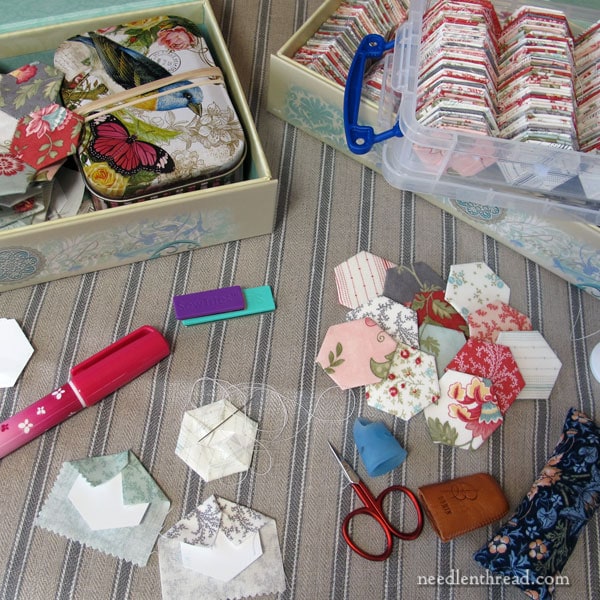
A couple little tools that I use, that I carry in the pouch I showed you in the previous article (and I’ve added a link for it at the end of the article – sorry I forgot to originally add it!) include a tiny pair of scissors, a Sewline glue pen, a couple SewTite magnetic tiles, my leather thimble, a silicone thimble for my thumb, needles, thread, and a little pin cushion that I made.
I have an extra thimble or two in the pouch, a needle threader in case I need it, some glue refills, and some extra needles, too.
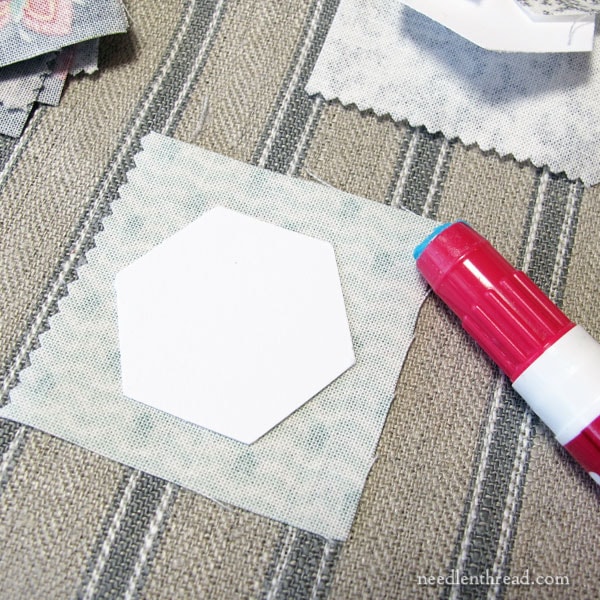
I do not cut my hexies into hexagon shapes with a seam allowance. Instead, since I’m working with 3/4″ hexies (3/4″ along each side), I cut my fabric into 2″ squares, and I just fold the squares over the card stock hexagon shape, to create the hexie. This saves an incredible amount of time, when it comes to cutting the fabric.
To baste the hexies so that they are ready for piecing, I place the fabric square face down with the card stock form about centered on top of it.
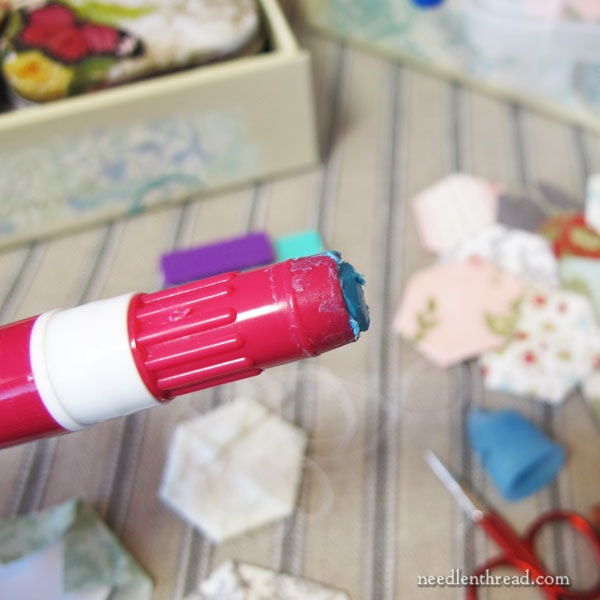
I use a Sewline fabric glue pen for the glue part.
Someone asked if I glue and baste, which seems like a waste of time. I compromise. I like the security of the basted hexie over time, rather than a hexie glued to the paper form.
But I also like the fact that the glue helps keep the paper form from shifting, while basting. It’s really annoying to be basting along happily, only to come to the fifth side and find that the paper shifted and you only have a very slim seam allowance.
To keep my paper forms from shifting while I baste, I use the glue on one corner.

I run a quick smear of the glue on this one corner of the hexie. It doesn’t have to be a lot – it looks like a lot because my glue pen was a bit gunky at this point!
But it doesn’t matter. The glue is not permanent. It’s easy to remove the paper from the center of the hexie (more on that below), especially with just one corner glued.

I fold the fabric over the corner as shown above. The direction of the fold is important to me because I’m right handed, and because of the way I baste. So I fold the lower side of the corner in first and the upper side over it.
I don’t put any glue on the fabric after the first fold, so there’s no glue on top of the first fabric fold.

This gluing and folding goes very quickly and it’s easy to prep a whole bunch of hexies for basting, by just gluing the one corner and tossing each prepped hexie into a box until there’s a nice collection for basting.
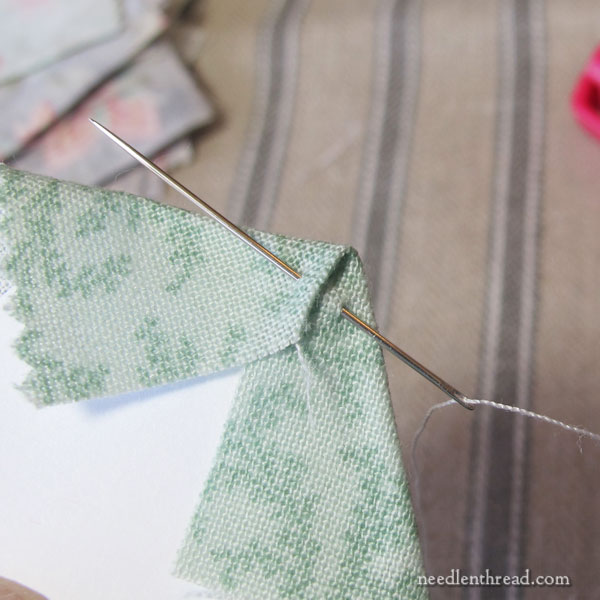
Then I baste!
I use all purpose cotton thread, with no knot in it. I pass the needle into the first (glued) corner, as shown above, going into the “lower” side of the fold and out into the “upper” fold on the corner. I pull the thread through, leaving a small tail.
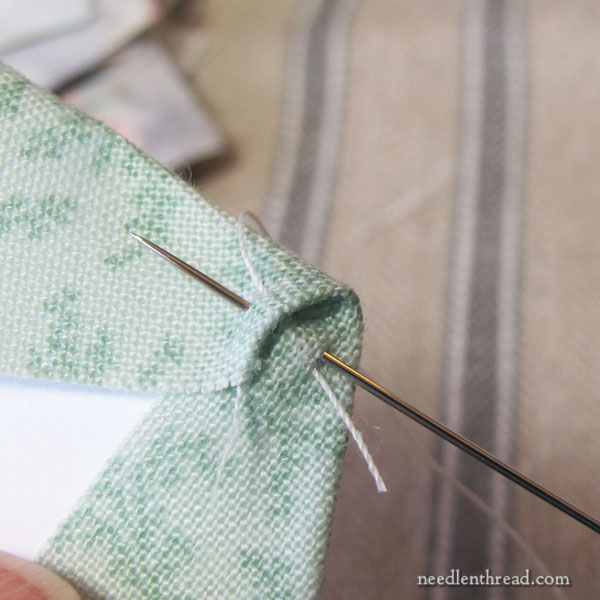
Then I pass back through that corner a second time. It’s like taking a little backstitch over each corner.
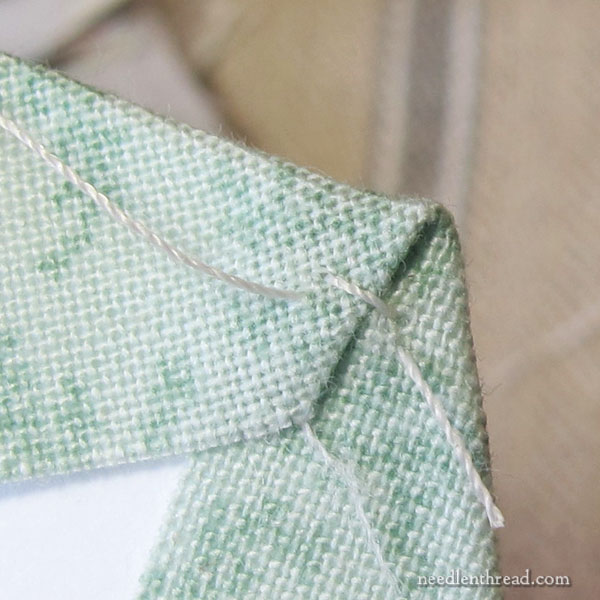
The stitch holds the corner neatly and firmly, and once all corners are basted, the hexagon shape is nicely defined around the paper form.
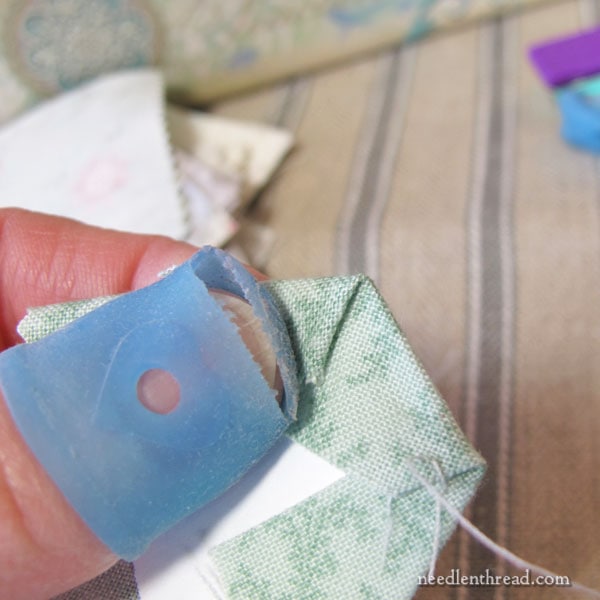
This looks dreadful, because it’s a fairly worn silicone thimble. I don’t remember the brand of this thing, but it’s ideal for using on my thumb when folding the edges of the fabric around the paper form.
I’m not using the thimble to protect the thumb from the needle. Rather, I’m using it to hold the fabric. The thimble is a soft and squishy silicone, and it holds the fabric in place for me without my having to use hardly any thumb pressure. Without it, I found that I was folding and holding the fabric too tightly, causing my thumb joint to hurt and the skin on the corners of my nails to split frequently. Once I started using the silicone thing, the silicone did the holding (because it has that slight stickiness to it), reducing the amount of work my thumb had to do.
So, to continue basting, it’s just a matter of folding each side of the hexie down over the previous side, making sure to manipulate the fabric for a neat, tight fold.
As it’s folded down, each corner gets that little backstitch over it, just like the first corner.

This is a basted hexie.
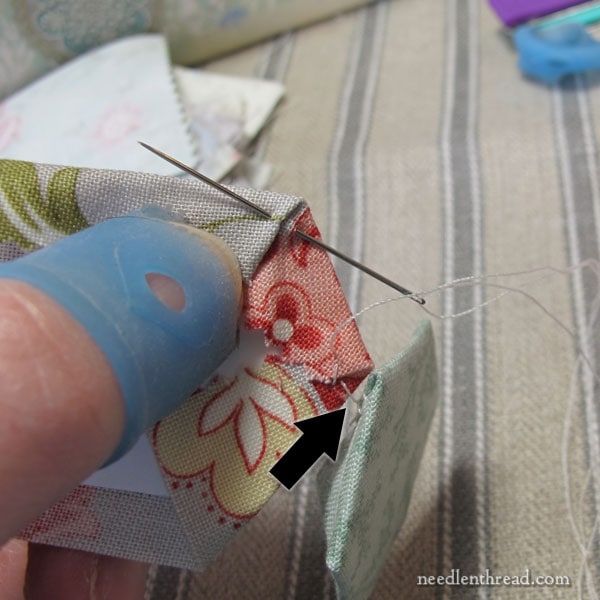
If I still have a lot of thread in my needle, I don’t cut the thread at this point. I just grab another prepped hexie and start basting.
This is a carry over from embroidery, I suppose! I don’t like ending a thread if I don’t have to, so I just baste a whole string of hexies until my thread runs out. I can baste about five or six hexies on the same thread without snipping the thread.
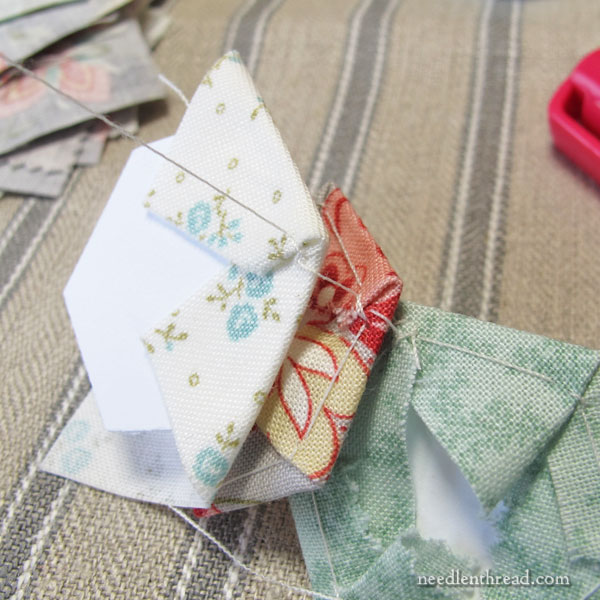
Here, you can see three hexies basted on the same thread, without the thread being snipped. It probably doesn’t save all that much time – it’s more a matter of laziness on my part. I just don’t like to end a thread if I don’t have to!
Once I’m out of thread, I’ll snip the hexies apart and I’ll add the little stack to my collection.
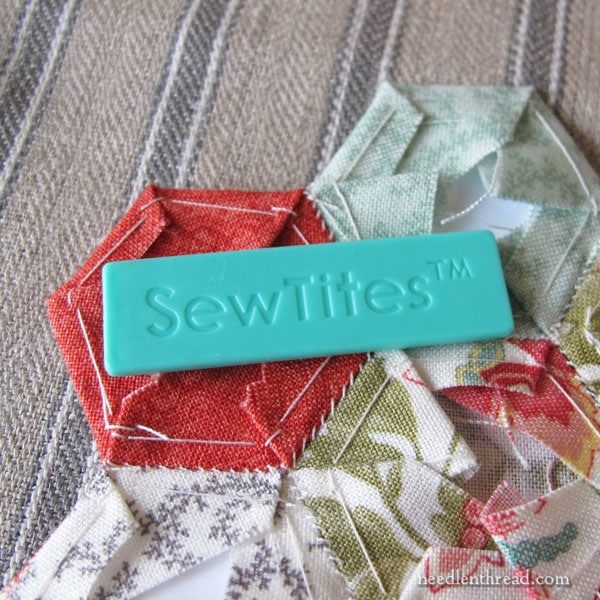
I sew my hexies together with a whipstitch, not a ladder stitch. The configuration of the stitch as it passes through from one hexie to another is the same (it forms a straight stitch across from one hexie to the other). The ladder stitch takes more time, so I prefer the whipstitch.
The paper form on the inside of the hexies makes a great guide for the needle, when whipstitching. The tip of the needle goes right into the edge of the fabric, just above the paper form. It’s important to avoid piercing the paper form when piecing.
Sometimes, I piece together strips of hexies. Sometimes, I piece the hexies in rounds and then sew the rounds together to make wider strips.
I use SewTite magnets that one of you kindly recommended to me to easily hold the hexies face-to-face when whipstitching them together. I like the way the SewTite magnets work – but I find them rather expensive for what they are. Still, it was a good investment for me, since they save my thumbs from inadvertently gripping the hexies together so hard as to cause joint pain.
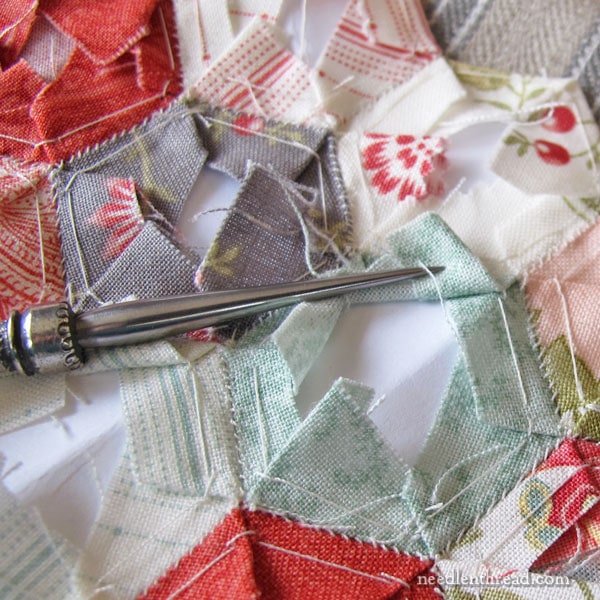
In the photo above, I’m using a laying tool to hold back the excess fabric to show you the paper form inside the hexies.
Two questions that came up:
Do I trim the excess fabric on the back of the hexies? No, I don’t.
Do I take the basting out once the hexies are sewn together? No, I don’t.
There’s really no reason to do either. The back of the hexies and the basting will be inside the quilt.
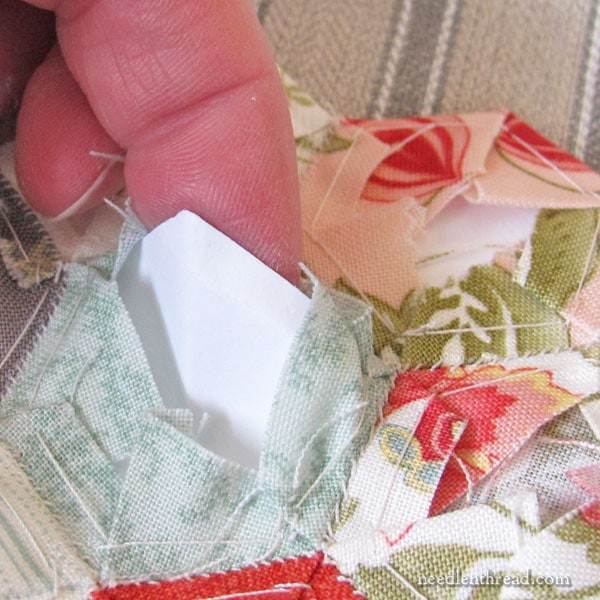
And another question: how do you remove the paper after basting?
I just slide my finger up under the fold of the fabric to the edge, and flip it out. It comes right out. The fabric peels easily from the corner that was glued, and unless you’ve pierced the paper and sewn through it when you stitched the hexies together, the paper is easy to remove. If you accidentally pierce the paper and sew through it, you just need to gently wiggle it until it comes loose. You might accidentally sew through the paper, but it would just be right on the very edge, so it doesn’t require too much manipulation to wiggle the paper out.
So that, my friends, is my process!
Whew.
I’m glad to be home for a bit – no more travel until the end of April, when I have a small sisters’ reunion to attend. That’s probably the next time I’ll play with my hexies.
In the meantime, I hope you have a wonderful weekend! Next weekend, I’ll share some fabric and other finds from my trip!
Where to Find
I’ve added a few of the handy items mentioned in this article – including the Sewline glue pen, the SewTites tiles, and other sundries I’ve used for my hexie quilt project – to my Amazon Recommendations page, under Tools & Accessories, if you’re looking for them.
My Amazon Recommendations page is an affiliate link, which means that Needle ‘n Thread receives a small commission for purchases made through that link at no additional cost to you. Every little bit helps keep Needle ‘n Thread online, so thanks!